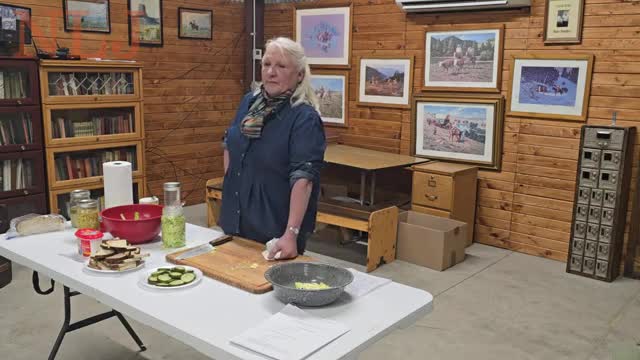Local chefs share techniques for making sauerkraut and sourdough bread
February 08, 2025 | Weston County, Wyoming
This article was created by AI summarizing key points discussed. AI makes mistakes, so for full details and context, please refer to the video of the full meeting. Please report any errors so we can fix them. Report an error »

At the recent Weston County Museum District meeting, the spotlight shone brightly on the health benefits and historical significance of fermented foods, particularly sauerkraut and sourdough bread. Attendees engaged in a lively discussion about how these traditional foods not only connect to local heritage but also offer substantial health advantages.
One participant highlighted the nutritional value of sauerkraut, noting its high vitamin C content, which was historically crucial for sailors to prevent scurvy during long voyages. "Cabbage was one of the best things to drink because it's really high in vitamin C," they explained, drawing connections to how Columbus brought pickles to America, emphasizing the role of fermented foods in early exploration.
The conversation also delved into the fermentation process itself, with participants sharing personal anecdotes about making sauerkraut and pickles. One attendee described their method, stating, "If you wanted to add seasonings to the sauerkraut, you probably could," showcasing the versatility of this age-old practice. The group discussed various vegetables that could be fermented, including carrots and radishes, and the benefits of using whole garlic cloves for added flavor.
Sourdough bread was another focal point, praised for its dense texture and lower impact on blood sugar levels compared to store-bought bread. "When you eat sourdough bread, it doesn't mess up your blood sugar as well," one participant noted, highlighting the health benefits of fermented flour and water.
The meeting also touched on the cultural exchange of these foods, with references to how German immigrants brought sauerkraut to America and how sourdough was introduced by French trappers. The discussion underscored the importance of these foods in the context of local history and their continued relevance in modern diets.
As the meeting wrapped up, attendees expressed enthusiasm about trying their hand at making sauerkraut and sourdough, with one participant declaring, "It's easy to make." The gathering not only celebrated the rich history of fermented foods but also encouraged community members to embrace these nutritious traditions in their own kitchens.
One participant highlighted the nutritional value of sauerkraut, noting its high vitamin C content, which was historically crucial for sailors to prevent scurvy during long voyages. "Cabbage was one of the best things to drink because it's really high in vitamin C," they explained, drawing connections to how Columbus brought pickles to America, emphasizing the role of fermented foods in early exploration.
The conversation also delved into the fermentation process itself, with participants sharing personal anecdotes about making sauerkraut and pickles. One attendee described their method, stating, "If you wanted to add seasonings to the sauerkraut, you probably could," showcasing the versatility of this age-old practice. The group discussed various vegetables that could be fermented, including carrots and radishes, and the benefits of using whole garlic cloves for added flavor.
Sourdough bread was another focal point, praised for its dense texture and lower impact on blood sugar levels compared to store-bought bread. "When you eat sourdough bread, it doesn't mess up your blood sugar as well," one participant noted, highlighting the health benefits of fermented flour and water.
The meeting also touched on the cultural exchange of these foods, with references to how German immigrants brought sauerkraut to America and how sourdough was introduced by French trappers. The discussion underscored the importance of these foods in the context of local history and their continued relevance in modern diets.
As the meeting wrapped up, attendees expressed enthusiasm about trying their hand at making sauerkraut and sourdough, with one participant declaring, "It's easy to make." The gathering not only celebrated the rich history of fermented foods but also encouraged community members to embrace these nutritious traditions in their own kitchens.
View full meeting
This article is based on a recent meeting—watch the full video and explore the complete transcript for deeper insights into the discussion.
View full meeting